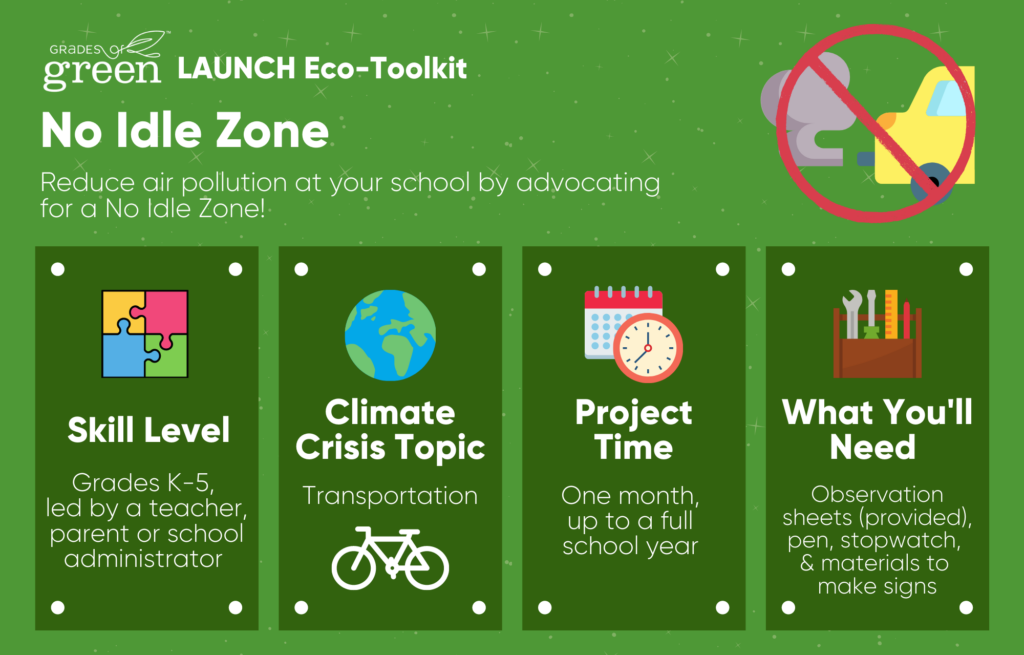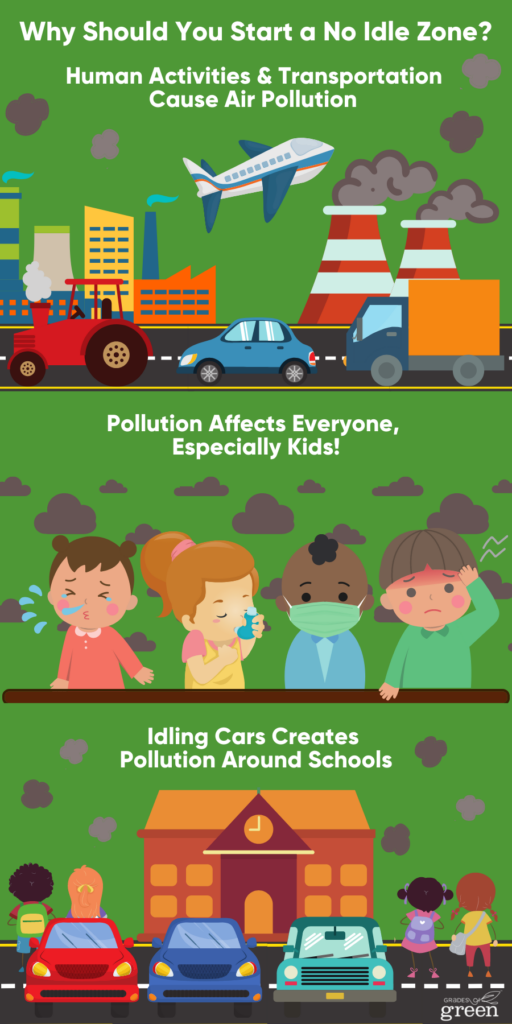What is Vehicle Idling? Vehicle Idling is when cars, trucks, buses, and other vehicles remain on and running while not moving. In this toolkit, you will help reduce exposure to harmful vehicle exhaust at your school by creating a No Idle Zone. Launch this No Idle Campaign to encourage parents, teachers, and other drivers to limit idling time for vehicles.

Toolkit Details


NGSS
This toolkit address the following Science and Engineering Practices (SEPs) within the Performance Expectations of NGSS for Grades: K-2 and 3-5
- Asking Questions and Defining a Problem
- Planning and Carrying out Investigations
- Analyzing and Interpreting Data
- Using Mathematics and Computational Thinking
- Constructing Explanations and Designing Solutions
- Obtaining Evaluating, and Communicating Information
Learning Objectives
- Analysis
- Students will collect and analyze data from “pick up points” to gain metrics for before and after the campaign
- Project Management
- Students will learn to run a public service campaign to its entirety
- Students will practice commitment to collection, analysis, and presentation of data
- Students will coordinate letters and pledges
- Students will practice leadership skills by delegating tasks to others
- Evaluation and Assessment
- Students will track and evaluate the impact of their project
Why It’s Important
Idling cars release harmful toxins, add to the global crisis of air pollution, and increase the risk of asthma in addition to other health effects in the developing lungs of children through the use of gasoline.
What You Will Accomplish
Students will run a public service campaign to reduce vehicle idling resulting in cleaner air around your school campus.
Educator Project Plan
Follow the steps below to set up a successful No Idle Zone at your school! Need help? Contact us!
Track your metrics and submit your impact after implementing this toolkit. Your feedback helps keep our programs free for all across the globe.
Determine Participants
- A Student Group such as (a club, before/after school program, non-school organization)
- A whole class
- The whole school
- Working with a small group of students? The group will observe the most trafficked pick up zone at school
- Working with a larger group? Split up into teams and have each observe the pick up zone on different days of the week OR each team can choose to observe a separate pick up zone
Why Should You Start a No Idle Zone
The resources provided can be shown as a slideshow or printed out as individual worksheets for students to learn.

Human activities cause air pollution
Every day human activities such as driving and manufacturing add greenhouse gasses and particulates to our air. These gasses and particulates cause air pollution which can be bad for the environment and our health. Additionally, these harmful gasses absorb heat from the sun and add to the already increasing temperature of the earth’s atmosphere.
Transportation creates pollution
The EPA has identified 188 Hazardous Air Pollutants also known as Air Toxics. Many of these come from cars and trucks that are on our roads every day. Pollution emitted from cars and trucks are called Mobile Source Air Toxics and are the largest contributors to air pollution in the US. [1]
Pollution affects everyone, but kids especially!
Toxins from cars and trucks have proven to cause serious health effects such as asthma and cancer. Children are even more at risk when surrounded by these toxins because their lungs are still developing. It is proven that when children are exposed to high levels of toxic air they are more likely to develop asthma, respiratory problems and other health complications. [1]
Idling cars create pollution around schools
Studies at school’s have shown that many parents tend to idle their vehicles when waiting to pick up their students and there are elevated levels of air toxics during these afternoon pickup times. While children’s lungs are especially susceptible to air pollution, limiting idling can dramatically reduce these pollutants and children’s exposure to them. [1]
Why Idling Vehicles is an Environmental Justice Issue
Idle vehicles relate to environmental justice due to our reliance on fossil fuel consumption. The production, use, and extraction of fossil fuels have numerous consequences on the environment they occupy. The areas where fossil fuels are extracted and processed are called “sacrifice” zones because the health and well-being of the local people and the environment are sacrificed in order to access the fuel. The residents that occupy “sacrifice” zones are often people of color, and the decision to sacrifice the area is most often made by people who do not live in or near the area.
Watch this short video to learn why it’s important to reduce carbon emissions!
Think About It
Pre-Activity Questions
- Describe the air pollution that you notice in your community, can you see or smell it?
- Why do you think many people leave their cars running when they are stopped?
- Why do you think it’s important for parents to turn off their cars when they are waiting to pick up their kids?
Take Action: How to LAUNCH a No Idle Zone
Lead Students in the “No Idle Zone” Activity with guided instructions. Check out “Pro Tips” with each step for useful help!
1. Determine Your Zones
- Draw or look at a map of your school
- Make a list of common zones that students get dropped off and picked up
- If there is more than one spot, split the group into teams so that all spots are covered
It’s amazing how much more people care about something once they’ve given it a name. Naming the different drop off and pick up spots can build a real feeling of ownership and pride. (Plus, it’s fun!)
2. Collect Your Data
- Gather your observation materials (Data Collection worksheet, stopwatch, pen, clipboard) and decide where students will safely be located at each pick up spot to collect data on idling cars.
- Review Observation Form with students, ensuring understanding of how to track idling. Working in groups of at least 3 is recommended. One student can take notes, one can keep track of time, and the last can check if cars are idling or not.
- Drivers should be told that they are collecting data for a transportation study. These pre campaign observations will be used to track the effectiveness of the campaign.
- For the next week, dismiss groups of students from class 10 minutes before school’s pickup time. They will go to their observation spots and collect data on idling cars. It is best if students can do this 3 – 5 days in a row to observe accurate data.
Take pictures of your team working in your zones. Everyone loves to see themselves and their friends in action. It’s a great way to build a sense of belonging and community. Create a unique hashtag or social media page for your photos.
3. Compile and Analyze Your Data
- When all observations are collected, compile data in this Observation Totals Sheet.
- Go the extra step: Use the EPA’s Analyzing Data sheet to determine how much gas and money is consumed while idling. If this step is too much for the students, do not include the type of vehicle in observations and calculations. (This data can be used as a baseline and is great for students to present to school administration, school board, or other students.)
4. Campaign for Drivers to Stop Idling
Now it’s time to begin the advocacy portion of the campaign! Please find resources below to encourage your broader school community to keep school an idle free zone. Use one or all of the provided resources:
- Policy – introduce no idle policy into handbooks and bus driver instructions. See example of No Idle Policy.
- Hold a Driver Contact Event – Dismiss students 10-15 minutes from pickup time to pick-up zones around school. Have them speak with parents, bus drivers, and others picking students up from school about the no idle campaign. Follow Instructions for EPA’s Driver Contact Event. Use this flyer from the EPA: Idle Free Schools!
- Pledges – Send Letter and Pledges home with students informing drivers about the campaign and encouraging them not to idle!
- Print Signs and post them around pick-up zones.
- Cleaner Air Sign (US EPA)
- No Idle Zone Sign (US EPA)
- Students can also present findings in the Observation Totals Sheet Pre-Campaign chart to the PTA or school board to garner support for the campaign.
Your Campaign can be spread out over the course of one month, one semester, or the whole school year! Depending on what timeline works best for you and your students.
Hold a contest to see which class on campus returns the most parent pledges! Incentivize the winning class with a prize such as a pizza party from a local vendor or gift cards/coupons!
Thank drivers who are not idling while reminding those who are idling about the policy!
5. Record Your Results
After the determined time has passed, repeat steps 2b – 4, having students collect data now that the school community has been informed and educated about Not Idling. Record Results on the Observation Totals Sheet Post-Campaign chart.
6. Analyze Your Success
Gather the Post Campaign data and compare it to observations from before to determine if the campaign was effective!
Reflection Questions
How’d It Go?
Student Reflection
- What were some small wins that happened during your project?
- Examples: we met the ice cream truck man, met my lifelong friends, caused 10 cars not to idle
- What could you do to up your game next time?
- Examples: use a better stopwatch, color code cars with different colored pens, take more pictures
- What’s the coolest thing that happened?
- Examples: met a police officer and convinced them not to idle
- What did you enjoy most about this campaign?
- Examples: observations with friends, getting out of class early, talking to parents
Report Students’ Impact
Congratulations!! You’ve implemented No Idle Zone! Don’t let all that hard work go unnoticed. Submit your results by clicking the green button below.
Project ongoing? No problem! Let us know what you’ve done so far.
Reporting your impact allows Grades of Green:
- CELEBRATE and elevate your students’ hard work and success. It also helps to
- Keeps our programs FREE for all students across the globe.
- Award stipends and certificates to amazing educators and students
Please take a few minutes to submit your results. Thank you!
Provided Resources

Congrats on completing the No Idle Zones project toolkit!
Did you enjoy this toolkit? Find your next project here!
Notes:
Resources were adapted from EPA’s Idle Free Schools Campaign.
This Toolkit was inspired by the following idling reduction programs: